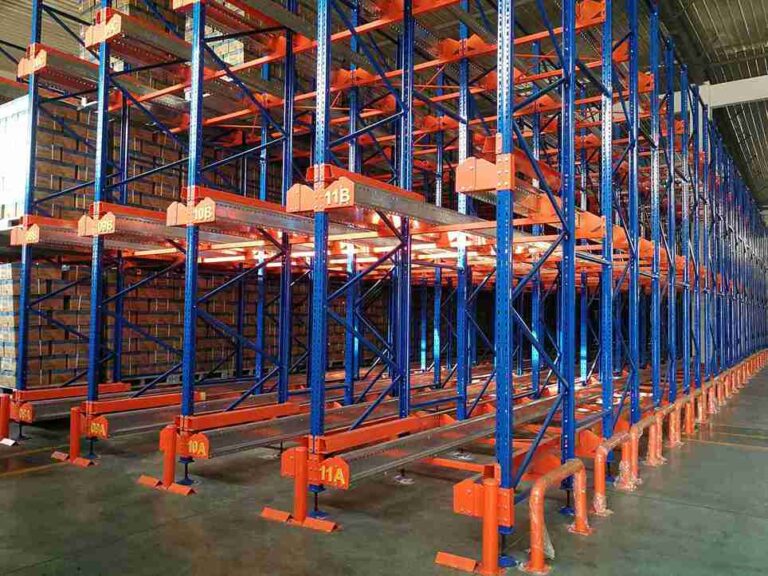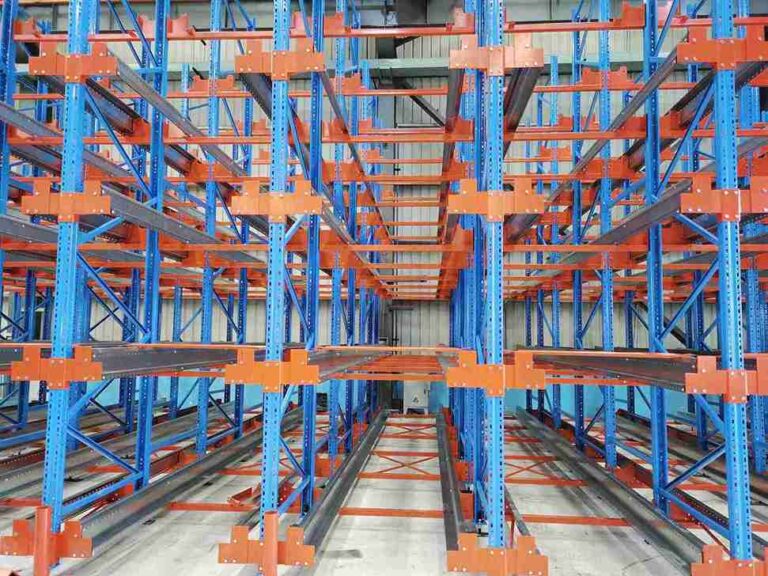📐 "First 50 Enterprise Queries Get Custom 3D Warehouse Design" Plan

In the evolving landscape of warehouse logistics, the demand for maximizing space and boosting throughput is more critical than ever. The shuttle racking system emerges as a game-changing solution in high-density storage. This article dives deep into the mechanics, benefits, practical applications, integration methods, and future trends of the shuttle racking system. Through detailed insights and real-world examples, supported by illustrative shuttle racking system videos, readers will gain a clear understanding of how this technology revolutionizes warehouse operations. Our analysis draws from decades of expertise in warehouse automation and logistics, aiming to guide businesses in making informed investments that yield rapid ROI and sustainable competitive advantage.

1. Introduction to the Shuttle Racking System
Warehouse storage solutions have undergone significant transformation over the past decades. The shuttle racking system represents a hybrid between traditional pallet racks and fully automated storage and retrieval systems (AS/RS). Designed specifically for deep-lane, high-density storage, it employs battery-powered shuttles that navigate rails within the rack lanes to move pallets quickly and accurately.
This approach bridges the gap between manual forklift operation and full automation, significantly reducing forklift travel time inside dense storage areas. As seen in most shuttle racking system videos, the system offers unparalleled efficiency and safety, making it ideal for businesses dealing with large volumes of pallets requiring fast turnover.
2. Core Components of a Shuttle Racking System
Understanding the components helps appreciate the system’s functionality:
Pallet Shuttle Cart: The heart of the system is a battery-operated shuttle vehicle that travels on rails embedded in each lane of the racking. It carries pallets deep into the racks, beyond forklift reach.
Multi-level Racking Structure: The racks are engineered to support dense storage with narrow aisles. The robust design accommodates multiple tiers, optimizing vertical space.
Control and Communication System: Operators manage shuttle movements remotely or through integrated Warehouse Management Systems (WMS). Modern systems use wireless communication protocols to track shuttle position and manage inventory dynamically.
The synchronization of these components is often best understood by watching a shuttle racking system video, which illustrates the seamless choreography between forklifts, shuttles, and control units.
3. Detailed Workflow of Shuttle Racking System Operations
3.1 Receiving and Storing Pallets
Upon arrival, forklifts place pallets at the rack entrance. The shuttle picks up the pallet, moving it horizontally into the storage lane. The shuttle deposits the pallet at the first available position or according to a FIFO/FILO logic, then returns for the next pallet. This process is repeated continuously, enabling rapid, uninterrupted pallet storage.
3.2 Retrieval Process
For picking operations, the shuttle fetches the requested pallet from deep within the rack and brings it back to the entry point. Forklifts then remove the pallet for dispatch or processing. The system eliminates the need for forklifts to enter narrow lanes, mitigating risks and enhancing throughput.
3.3 Video Demonstrations
High-quality shuttle racking system videos visually communicate the efficiency of these operations, showing real-time shuttle movements, system responsiveness, and error handling, providing valuable insights for warehouse managers and engineers.
4. The Competitive Advantages of Shuttle Racking Systems
4.1 Maximized Storage Density
Compared with drive-in racks or selective racking, the shuttle racking system achieves significantly higher storage density by eliminating multiple aisles and allowing deep-lane storage. This efficiency reduces warehouse footprint requirements or enables expanded inventory capacity in existing spaces.
4.2 Safety Improvements
Because forklifts do not enter rack lanes, the risk of damaging racks or pallets is drastically reduced. This improves worker safety and lowers maintenance costs, a key consideration for warehouses with high forklift traffic.
4.3 Operational Efficiency and Throughput
Automating pallet transport within lanes accelerates loading and unloading cycles. Operators can handle more pallets per shift, reducing bottlenecks and increasing customer satisfaction through faster deliveries.
4.4 Flexibility in Storage Logic
The system supports both FILO and FIFO inventory management. This flexibility caters to various industries—from perishable goods requiring strict FIFO to non-perishables where FILO is acceptable.
4.5 Labor and Cost Savings
With fewer forklift operators needed inside lanes, labor costs drop. Additionally, a single operator can remotely control multiple shuttles, optimizing workforce allocation and reducing downtime.
5. Real-World Industry Applications
5.1 Food & Beverage Cold Storage
Cold storage environments benefit from the shuttle system’s ability to minimize forklift time in low-temperature areas, reducing energy loss and enhancing safety. The shuttle’s battery technology and durable design ensure reliable operation in sub-zero temperatures.
5.2 Fast-Moving Consumer Goods (FMCG)
FMCG warehouses require rapid turnover. The shuttle racking system delivers on speed and space efficiency, enabling companies to meet high demand fluctuations with agility.
5.3 Pharmaceuticals
Strict inventory control and temperature-sensitive storage benefit from the shuttle system’s precision and integration with WMS for real-time tracking.
5.4 Third-Party Logistics (3PL)
3PL providers benefit from the system’s scalability and operational cost reduction, enabling flexible service offerings.
5.5 Automotive and Manufacturing Components
Large, heavy pallets in automotive parts warehousing gain from the system’s robustness and space-saving benefits.
6. Deployment: From Planning to Commissioning
6.1 Initial Warehouse Assessment
A thorough evaluation of warehouse dimensions, floor load capacity, and ceiling height is essential. Engineers must map column positions to design rack layouts maximizing usable space without compromising safety.
6.2 Structural Compatibility and Customization
Racks must be engineered for specific load requirements and environmental factors. Custom solutions can address special conditions such as seismic zones or extreme temperatures.
6.3 Shuttle Configuration and Charging Infrastructure
Battery life and charging schedules are critical. Installing efficient charging stations and scheduling shuttle rotations reduce downtime and maintain continuous operation.
6.4 Staff Training and Safety Protocols
Operators must receive detailed training on shuttle control, emergency procedures, and system monitoring. Comprehensive training programs often include instructional shuttle racking system videos.
7. Maintenance Best Practices and Troubleshooting
Regular maintenance ensures system longevity and peak performance:
Daily checks on shuttle battery status and charging stations prevent unexpected shutdowns.
Keeping rails and tracks free from debris ensures smooth shuttle movement.
Firmware updates address bugs and improve system functionality.
Routine inspections by qualified technicians minimize breakdown risks.
Troubleshooting guides and video tutorials empower onsite teams to resolve common issues swiftly, minimizing operational interruptions.
8. Integration with Warehouse Management Systems (WMS)
8.1 Enhancing Inventory Accuracy
Integrating the shuttle racking system with WMS allows for automatic updates of inventory locations, reducing human error and speeding up stocktaking.
8.2 Optimizing Storage and Retrieval
WMS integration facilitates dynamic slotting, enabling the system to optimize pallet placement based on turnover rates and product characteristics.
8.3 Real-Time Monitoring and Analytics
Warehouse managers gain visibility into shuttle status, battery levels, and throughput metrics, enabling data-driven decisions for continuous improvement.
9. Comparative Analysis: Shuttle Racking System vs. Traditional Storage
| Feature | Shuttle Racking System | Drive-In Racking | Selective Racking |
|---|---|---|---|
| Storage Density | High | Moderate | Low |
| Safety | High | Low | High |
| Forklift Entry | No | Yes | Yes |
| Throughput Speed | High | Medium | High |
| Inventory Rotation | FIFO / FILO | FILO | FIFO |
This table demonstrates the shuttle system’s superior balance between density, safety, and speed, often confirmed through operational videos.
10. Future Trends in Shuttle Racking System Technology
The future of shuttle racking systems is closely tied to advancements in AI and IoT:
Machine Learning: Adaptive routing algorithms optimize shuttle paths dynamically based on real-time warehouse conditions.
Predictive Maintenance: IoT sensors embedded in shuttles and racks predict failures before they occur, reducing downtime.
Robotics Integration: Combining shuttles with Automated Guided Vehicles (AGVs) and robotic arms enables fully autonomous warehouses.
Manufacturers showcase these innovations in cutting-edge shuttle racking system videos, attracting interest from forward-thinking logistics companies.
11. Selecting a Reliable Shuttle Racking System Provider
Key considerations when choosing a supplier include:
Proven experience in high-density storage solutions design and implementation.
Strong after-sales support and warranty policies.
Availability of comprehensive training resources and demonstration videos.
Client testimonials and case studies showcasing successful deployments.
Trustworthy providers differentiate themselves through transparent communication, technical expertise, and post-installation support.
Conclusion
The shuttle racking system stands as a pivotal innovation in the quest for efficient, safe, and scalable warehouse storage. Its ability to maximize space, enhance throughput, and reduce labor costs makes it an indispensable tool for modern logistics operations. Companies seeking to elevate their warehouse capabilities should seriously consider investing in this technology. Observing a detailed shuttle racking system video can provide invaluable clarity on its operational excellence and ROI potential.
Frequently Asked Questions (FAQs)
Q1: What is the maximum pallet weight capacity for a shuttle racking system?
Most shuttles are designed to handle pallet weights up to 1,500 kg, depending on the model and manufacturer.
Q2: How quickly can a company expect ROI after installing a shuttle racking system?
Typical ROI ranges from 1.5 to 3 years, influenced by throughput volume and operational efficiency gains.
Q3: Can shuttle racking systems operate reliably in cold storage environments?
Yes, they are engineered to function in temperatures as low as -30°C, making them ideal for refrigerated warehouses.
Q4: How many shuttles are typically required for a medium-sized warehouse?
A general rule is one shuttle per 500 to 1,000 pallet positions, but this varies with operational demands.
Q5: Are shuttle racking systems compatible with other automation like AGVs or AMRs?
Integration with Autonomous Guided Vehicles (AGVs) and Autonomous Mobile Robots (AMRs) is increasingly common, creating highly automated warehouse ecosystems.
If you need warehouse racking CAD drawings, we can do warehouse racking planning and design for free, you can consult us. Our email: jili@geelyracks.com.




